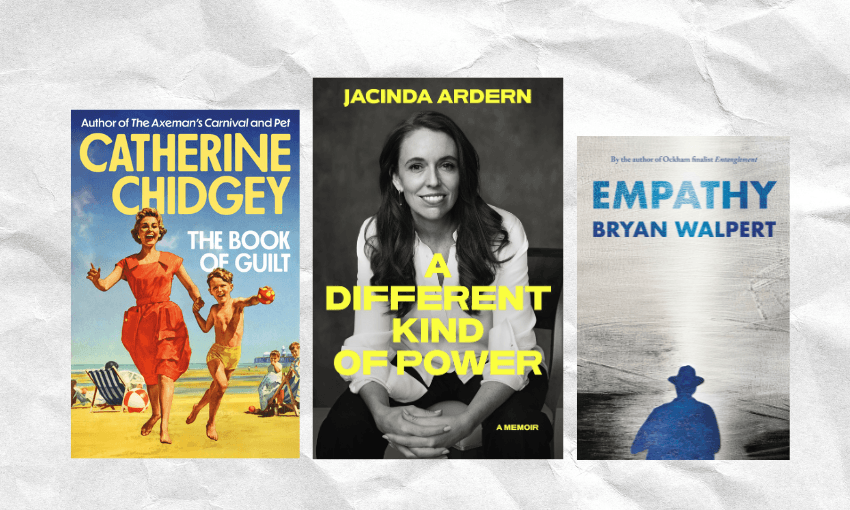Sam Brooks reviews Before the Coffee Gets Cold – which Aucklanders, inexplicably, will not stop buying – and finds a book that sits oddly out of its native language and native form.
For an extraordinary five weeks straight, a certain slim $20 novel has topped the Unity Auckland charts. That’s after making the Top 10 every week since November – actually, ever since being savaged by Ralph McAllister on RNZ: “This is probably the worst book I have read all year,” he told Nine to Noon. (Wellington has steered clear).
The book is by Japanese author and playwright Toshikazu Kawaguchi and was published in 2015; the version Auckland is all over is an English translation released here quietly in September. The success is bizarre and seemingly out of nowhere. While the book is a hit in Japan, it hasn’t been reviewed in any major English publications and it hasn’t become a social media sensation like other chart-toppers such as, say, Sally Rooney’s Normal People, the book that seemingly everyone has read or at least owns.
It honestly sounds like an author’s dream: to have everybody reading your book and nobody actually talking about it. I feel like Jeanine Cummins would take that option over whatever the hell is happening with American Dirt.
On the back of this mystery, and a few choice keywords that fit my personal Venn diagram of interests (Japan, time travel, gentle, cafe), I signed up to review it. It made me even more curious that the book was an adaptation of a play, also written by Kawaguchi. Plays adapted from books are not uncommon – a few of our finest plays existed as novels first (oh hey, Dead City, the only acceptable version of Ulysses, including the source text) – but books adapted from plays aren’t common at all.
I had questions: What was making people, in Auckland at least, rush to buy this book in whatever size droves that get your book to the top of the Unity Charts? Was it any good? Why was nobody talking about it?
To answer those in reverse order: There’s not especially much to talk about, it’s somewhere between “just fine” and “not very good”, and I have no idea why so many people are buying it.
Once you remove it from its context – that perplexing success – Before the Coffee Gets Cold becomes rapidly less interesting.
That’s a shame, because its premise tugs at your heart if you happen to have one capable of nostalgia and romance. It’s set in a cafe that offers the chance to travel back in time, with a few seemingly arbitrary rules. People who time travel can’t change the past, they can’t move from one specific seat in that cafe, and they have to return before their coffee turns cold or they’ll be stuck in that seat forever, like a certain ghost woman who can move only to use the toilet once a day. The four stories in the novel are split into chapters – ‘The Lovers’, ‘Husband and Wife’, ‘The Sisters’, and ‘Mother and Child’ – and cover four people who wish to go back in the past, to revisit their mistakes, even knowing they can’t change them.
I think everyone has at least one moment that they’d want to return to, or maybe try to change. Perhaps you want to revisit an especially nice lunch with someone you’ve lost, or look back on a conversation which changed your life entirely. Before the Coffee Gets Cold takes four different approaches to these moments, each tragic and beautiful in their own way, and each designed to elicit the maximum amount of tears. It’s so calculated, in fact, that it feels like the author is quietly cutting onions in the same room as you: this is where you cry, reader.
These moments are almost effective enough to make you forget that, on a sentence-by-sentence, phrase-by-phrase level, the novel is shockingly simplistic. Take this passage on page five, describing the protagonist of the story ‘The Lovers’ who hopes to revisit a fight she had with her boyfriend she wishes had gone differently:
“Fumiko’s looks were better than ordinary. Blessed with well-defined features and petite lips, she had the face of a pop idol. Her mid-length black hair shone and crowned her with a glowing halo. Despite her conservative clothes, her exceptional figure was easy to discern. Like a model from a fashion magazine, she was a beautiful woman who would draw anyone’s gaze. Yes, she was a woman who combined intelligence and beauty. But whether she realised this was a different matter.”
It’s almost like bad, shallow writing is an indicator of bad, shallow thinking. While that section is thankfully the nadir of Before the Coffee Gets Cold, it’s also representative of the kind of the clunky phrasing common to the entire novel, or at least the translation. It’s not so much minimalist writing as it is writing that isn’t there at all.
That being said, it’s hard to deny the cumulative effect of these stories. Kawaguchi has an aptitude for shifting the focus from person to person over the four stories, so certain characters slip into the centre stage almost seamlessly, and we realise that we’ve grown to actually known this character incredibly well. The final story, featuring a character who works at the cafe, is the most successful. But it’s less down to great writing, and more a result of good staging.
Which brings me to the main issue with the book: God, I’d rather see this play out in a theatre.
I don’t think the best stories are those that can be adapted into any form. The best stories are ones that make the most of their native form. I’m talking about something like Sarah Kane’s 4:48 Psychosis, perhaps the most raw vivisection of the suicidally depressed mind I’ve ever seen, which wouldn’t work in any non-theatrical form. Even something like Gris, a video game that immerses you in the grieving process, gets its power from the fact that you are playing through grief, not being told about it.
Even sight unseen, I can guess that on stage Before the Coffee Gets Cold isn’t exactly Strindberg, or to use a comparison from Kawaguchi’s actual country, not exactly Sakate. But the novel’s space-driven narrative, and the slow cumulative effect of characters crashing into each other’s orbits, is so much better suited to a physical space than an imagined one. It’s the character of the ghost woman – the woman who didn’t drink her coffee while it was warm, and so is stuck in the chair – that makes me certain of this. It’s not difficult to imagine the physical comedy of a woman sitting quietly onstage, reading her book, more or less a part of the furniture herself, becoming enraged when someone tries to move her from her seat. It’d be a treat for an actor, and a treat for an audience to watch. As a reader, however, these bits feel more like a reminder, a tap on the shoulder that yes, this woman is still here. The novel seems to be constantly reminding us that we’re in a cafe, and in so doing it stops plot, and the characterisation, dead in its tracks. If we could see it, we wouldn’t need to be told it.
Despite these shortcomings, it’s not a huge surprise to me that the book was a hit in Japan. I’ve no doubt that it reads better in its native language, just as I’m sure it played better in its native artform. It’s a gentle sigh of a book that I can’t imagine anybody but your surliest, most cynical friend (hi!) truly disliking. As for why it’s a hit here, I still couldn’t tell you, because it’s just that: A gentle sigh. It’s a book you forget before, well, the coffee gets cold.
Before the Coffee Gets Cold by Toshikazu Kawaguchi (Picador, $20) is available from Unity Books.



